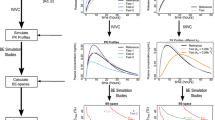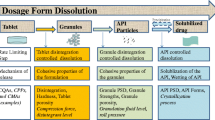Abstract
One of the most commonly used methods to establish the clinical relevance of dissolution is to align the dissolution specifications with pivotal clinical batches. The objective of the study was to create edge charts for the dissolution of immediate release (IR) drug products to quantitatively establish the bases for setting clinically relevant and discriminating dissolution specifications and to clarify which stage in the US Pharmacopoeia (USP) <711> acceptance tables should be targeted. The simulations of dissolution data were performed on a batch of IR products with 1,000,000 units. The desired acceptance criterion was Q = 80% of the label claim at 30 min. A total of 110 scenarios for IR data were generated, which included various combinations of two determinants: the batch mean and SD (standard deviation). For each scenario, the dissolution data were tested based on USP three-stage procedures to determine the pass/fail at each stage. This process was repeated 10,000 times. The failure rate at each stage for each scenario was calculated as the percentage of failed replicates across 10,000 trials. Contour plots, named edge charts, were created to demonstrate the relationship between the dissolution failure rates and the two determinants (mean and SD). The edge lines represent the failure rates for the given combinations of the mean and SD. The edge charts can provide a quantitative estimate based on the observed dissolution data and provide fundamental support for recommendations on using USP stage 2 as a target for setting the acceptance limit(s).






Similar content being viewed by others
References
U.S. Department of Health and Human Services, Food and Drug Administration, Center for Drug Evaluation and Research. Guidance for industry: extended release oral dosage forms: development, evaluation and application of in vitro/in vivo correlation. September 1997.
U.S. Department of Health and Human Services, Food and Drug Administration, Center for Drug Evaluation and Research. Guidance for industry: nonsterile semisolid dosage forms. Scale-up and postapproval changes: chemistry, manufacturing and controls, in vitro release testing, and in vivo bioequivalence documentation. May 1997.
U.S. Department of Health and Human Services, Food and Drug Administration, Center for Drug Evaluation and Research. Guidance for industry: waiver of in vivo bioavailability and bioequivalence studies for immediate-release solid oral dosage forms based on a biopharmaceutics classification system. December 2017.
U.S. Department of Health and Human Services, Food and Drug Administration, Center for Drug Evaluation and Research. Guidance for industry: immediate release solid oral dosage forms. Scale-up and postapproval changes: chemistry, manufacturing and controls, in vitro dissolution testing, and in vivo bioequivalence documentation. November 1995.
U.S. Department of Health and Human Services, Food and Drug Administration, Center for Drug Evaluation and Research. Guidance for industry: dissolution testing of immediate release solid oral dosage forms. August 1997.
U.S. Department of Health and Human Services, Food and Drug Administration, Center for Drug Evaluation and Research. Guidance for industry: modified release solid oral dosage forms: scale-up and postapproval changes: chemistry, manufacturing and controls, in vitro dissolution testing, and in vivo bioequivalence documentation. September 1997.
U.S. Department of Health and Human Services, Food and Drug Administration, Center for Drug Evaluation and Research. Guidance for industry: bioavailability and bioequivalence studies submitted in NDAs or INDs: general considerations. 2014.
Hermans A, Abend AM, Kesisoglou F, Flanagan T, Cohen MJ, Diaz DA, et al. Approaches for establishing clinically relevant dissolution specifications for immediate release solid Oral dosage forms. AAPS J. 2017;19:1537–49. https://doi.org/10.1208/s12248-017-0117-1 .
Abdullah MDA, Bepary S, Rouf ASS. Report: in vitro dissolution studies of different brands of sustained release diclofenac sodium matrix tablet available in Bangladesh. Pak J Pharm Sci. 2008;21:70–7.
Adegbite AI, Adegbolagun OM. Evaluation of the physicochemical equivalence of three brands of commercially available quinine sulphate tablets from South Western part of Nigeria. Afr Health Sci. 2011;11:197–203.
Belew S, Suleman S, Wynendaele E, D'Hondt M, Kosgei A, Duchateau L, et al. Quality of anthelminthic medicines available in Jimma Ethiopia. Acta Trop. 2018;177:157–63. https://doi.org/10.1016/j.actatropica.2017.10.006 .
Gasser UE, Fischer A, Timmermans JP, Arnet I. Pharmaceutical quality of seven generic Levodopa/Benserazide products compared with original Madopar® / Prolopa®. BMC Pharmacol Toxicol. 2013;14:24. https://doi.org/10.1186/2050-6511-14-24 .
Nightingale CH. A survey of the quality of generic clarithromycin products from 18 countries. Clin Drug Investig. 2005;25:135–52.
R Core Team. R: a language and environment for statistical computing. Vienna, Austria: R Foundation for Statistical Computing; 2018.
Sarkar D. Lattice: multivariate data visualization with R. Deepayan Sarkar. New York, London: Springer. 2008.
Moore JW, Flanner HH. Mathematical comparison of dissolution profiles. Pharm Technol. 1996;20:64–75.
Duan JZ, Riviere K, Marroum P. In vivo bioequivalence and in vitro similarity factor (f2) for dissolution profile comparisons of extended release formulations: how and when do they match? Pharm Res. 2011;28:1144–56. https://doi.org/10.1007/s11095-011-0377-x .
Li M, Sander S, Duan J, Rosencrance S, Miksinski SP, Yu L, et al. Scientific and regulatory considerations in solid Oral modified release drug product development. AAPS J. 2016;18:1406–17. https://doi.org/10.1208/s12248-016-9974-2 .
Author information
Authors and Affiliations
Additional information
Publisher’s Note
Springer Nature remains neutral with regard to jurisdictional claims in published maps and institutional affiliations.
Rights and permissions
About this article
Cite this article
Duan, J.Z. Dissolution Edge Charts for Immediate Release Products and Their Applications: a Simulation Study to Aid the Setting of Specifications. AAPS J 21, 36 (2019). https://doi.org/10.1208/s12248-019-0308-z
Received:
Accepted:
Published:
DOI: https://doi.org/10.1208/s12248-019-0308-z




